The Clevo P870DM2 / Mythlogic Phobos 8716 Laptop Review: DTR With GTX 1080
by Brett Howse on October 27, 2016 2:00 PM ESTGPU Performance
This is really the section that is the most interesting. This is our first look at Pascal in a notebook, and it really can’t be understated just what a big transition this is on the notebook side. Maxwell was a fantastic launch by NVIDIA, but it was the final play on the 28 nm process they had been using for so long. With the launch of Pascal, they finally get to exploit a new 16 nm TSMC process to improve performance and efficiency across the board.
| NVIDIA High-End Mobile GPU Specification Comparison | ||||||
| GTX 1080 | GTX 980 | GTX 980M | GTX 880M | |||
| CUDA Cores | 2560 | 2048 | 1536 | 1536 | ||
| Texture Units | 160 | 128 | 96 | 96 | ||
| ROPs | 64 | 64 | 64 | 32 | ||
| Core Clock | 1556MHz | 1064MHz | 1038MHz | 954MHz | ||
| Boost Clock | 1733MHz | Undefined | Undefined | Undefined | ||
| Memory Clock | 10Gbps GDDR5X | 7Gbps GDDR5 | 5Gbps GDDR5 | 5Gbps GDDR5 | ||
| Memory Bus Width | 256-bit | 256-bit | 256-bit | 256-bit | ||
| VRAM | 8GB | 4GB/8GB | 4GB | 4GB | ||
| FP64 | 1/32 | 1/32 | 1/32 | 1/24 | ||
| GPU | GP104 | GM204 | GM204 | GK104 | ||
| Transistor Count | 7.2B | 5.2B | 5.2B | 3.5B | ||
| Manufacturing Process | TSMC 16nm | TSMC 28nm | TSMC 28nm | TSMC 28nm | ||
| Launch Date | 08/16/2016 | 09/22/2015 | 10/07/2014 | 03/12/2014 | ||
The change was so significant that NVIDIA has completely rebranded the notebook parts with the same branding as the desktop parts, and it’s not just an illusion. The GTX 1080, which is the card outfitted in the review unit, features the same 2560 CUDA cores as the desktop part, the same 8 GB of 10 Gbps GDDR5X, and the same ROPs as the desktop card. The only difference is a small drop in the core clock rate to keep the TDP in check, but it does keep the same 1733 MHz boost clock. Compare this to the outgoing GTX 980M which was pretty dominant in its time, which had just 1536 CUDA cores with a 1038 MHz core clock. Even the short lived GTX 980 for notebooks had only 2048 CUDA cores at 1064 MHz. GTX 1080 in a notebook is a serious jump in capabilities. Thanks to Mythlogic for sending us one right after launch so we could check it out.
We’ve run the laptop through our gaming tests, with a couple of new ones added as well. To compare the Clevo P870DM2 to any other notebook we’ve tested, check out the notebook bench.
3DMark
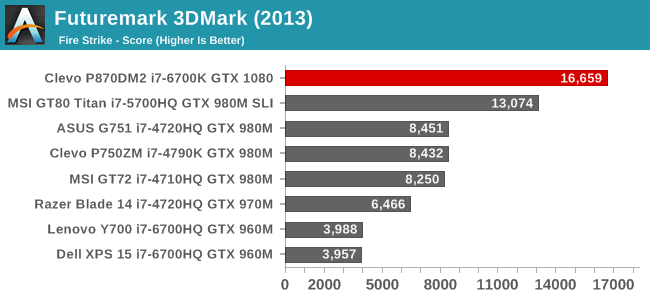

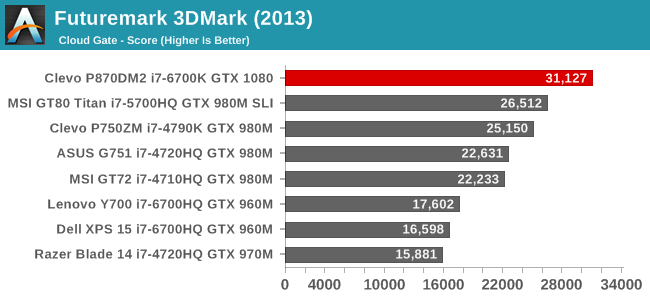
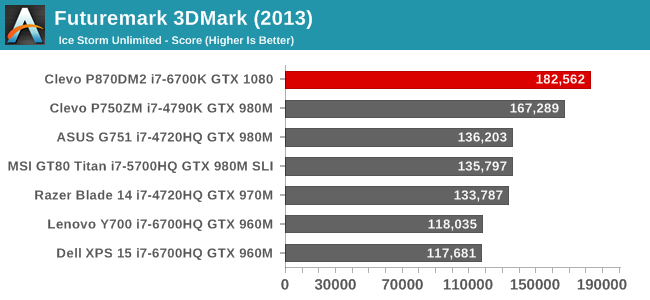

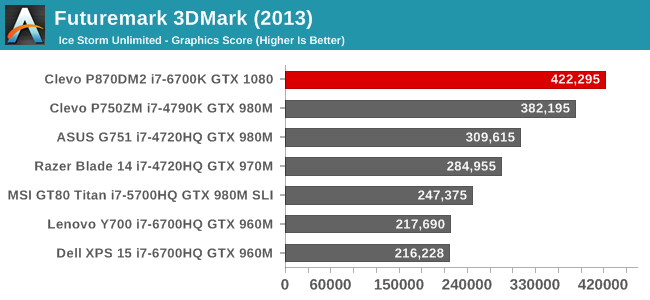
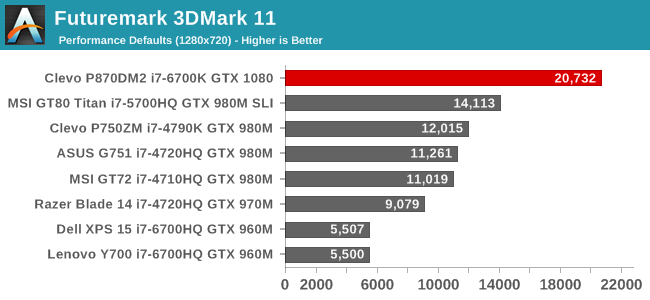
First up is a couple of synthetic tests. Futuremark’s 3DMark is a long-standing graphics test, and makes for an easy comparison across devices. Here it is already apparent just how much of a jump in performance the NVIDIA GTX 1080 is compared to the GTX 980M in the outgoing models. Even the SLI GTX 980M in the MSI GT80 Titan has no chance against a single GTX 1080.
GFXBench

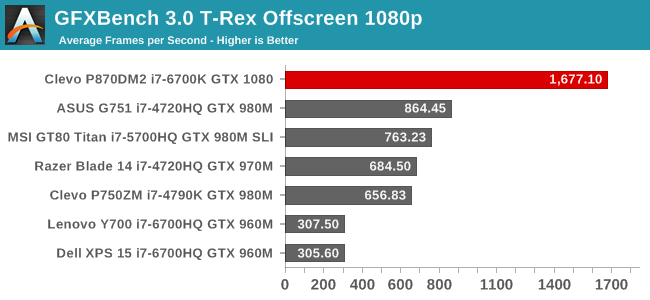
Once there are a couple more data points, we’ll have to move to the newer versions of GFXBench, but this mobile focused test is really not a stress at all on any desktop GPU. Still it’s fun to see just how far these can go, and the GTX 1080 sets a ridiculous score of 1677 frames per second in T-Rex.
Bioshock Infinite
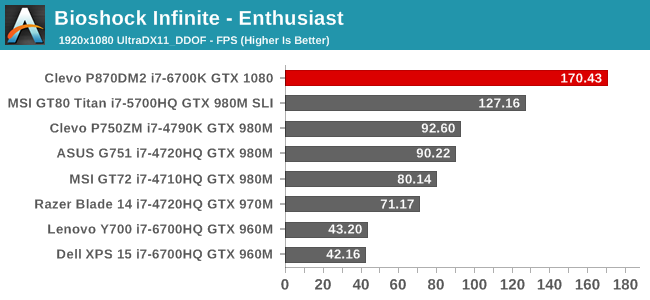
This game is getting a bit long in the tooth, but it has still been a decent notebook benchmark when turned up to Ultra settings. There is also a great amount of data going back many years, which is helpful too. Once again, the GTX 1080 demolishes this test with 170 frames per second on our enthusiast settings.
Dragon Age Inquisition

This epic RPG from Bioware is one of my favorite games ever, and at maximum settings it can really punish graphics cards too. At 115 fps, this is the first game to come close to the 120 Hz of the display, but still the gulf between the GTX 980M and the GTX 1080 is gigantic.
GRID Autosport
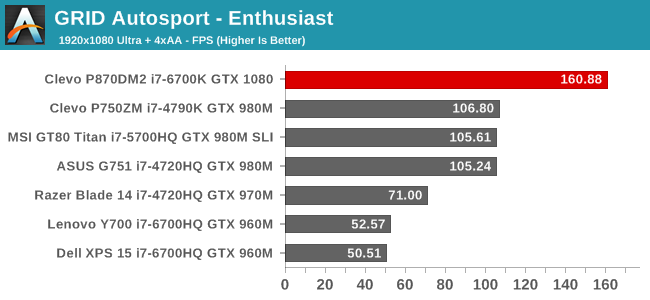
Once again, the giant leap in performance is on display here. GRID is more CPU bound than some other games, at least on the same GPU architecture, but Core i7-6700K with GTX 1080 has no issues.
Shadow of Mordor

Once again, Shadow of Mordor has been a good test for notebooks, with previous generation devices barely getting an average of 60 FPS on Ultra settings, but the GTX 1080 has no such problems, with the new laptop having a framerate 242% of the GTX 980M in the Clevo P750ZM. The SLI GT80 Titan is a bit closer, but still isn’t in the same league.
Tomb Raider
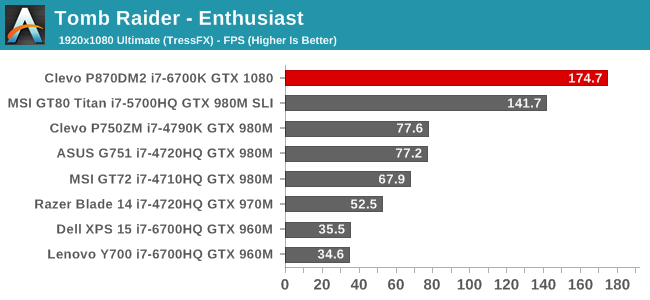
The original Tomb Raider is such a great game that it would be difficult to see it go, but now with Rise of the Tomb Raider available, once there are some more data points for the new version, the old one will have to be relegated to the history books. This was one of the games that SLI helped a lot on, and you can see that the SLI GTX 980M in the GT80 Titan pulls pretty close to the GTX 1080, but compared to a single GTX 980M in the P750ZM, the GTX 1080 is 225% faster.
Rise of the Tomb Raider


Despite this being a new DX12 game, you can see that the GTX 1080 really has no issues running it at 1920x1080. The Very High settings need a lot of vRAM, and the 4 GB vRAM in the ASUS G751 GTX 980M couldn’t even complete the benchmark on Enthusiast settings, so just to give a generational showing the Mainstream settings of 1600x900 High are also shown.
Dota 2

If you’re a big fan of eSports, or just a fan of online arena battle games, Dota 2 might be the game you play. If so, fret not. The GTX 1080 does pretty well on this game.
Civilization VI

Only just released, Civilization VI is the latest game in the Civilization series. Civ has generally been pretty intense on the CPU, and it appears that is the case again with Civilization VI. No other systems have been tested (yet) but just for some sort of comparison, my desktop with the same CPU, but a GTX 760, would only get about 25 FPS on the Enthusiast settings. 80 FPS is by far the lowest score on any of the gaming tests, but at the same time the game engine is pretty CPU limited. The difference between 1366x768 Medium and 1920x1080 Ultra is not very significant, which is a good indication that the game is limited in a non-GPU way.
GPU Conclusion
Comparing the GTX 1080 to any previous GTX M branded card is going to show, once again, just what a jump the move to 16 nm Pascal is. The GTX 1080 is easily twice as fast, or more, than the GTX 980M. There seems to be a good reason NVIDIA decided to drop the mobile branding, because the gap between notebook and desktop is as small as ever.










61 Comments
View All Comments
ZeDestructor - Thursday, October 27, 2016 - link
Picture of the innards clearly shows one MXM module populated with an empty slot for a second MXM module. With two MXM cards installed, the heatsink for each GPU is shrunk by half though (second card takes over the second fan and gimps the first card to only having the leftmost fan), so there will be a lower boost max.Glaurung - Thursday, October 27, 2016 - link
"Let's be real, you aren't moving this thing around. Just buy a desktop."A laptop takes up much less room than a desktop, and you can close the lid and stow it away in a drawer. Whereas a desktop is always going to be hogging space on your desk for its keyboard, mouse, and monitor. For someone with a small apartment or student dorm room, the ability to simply close the lid and stow the whole thing away is a huge benefit. Don't think of this as a battery powered portable computer, think of it as a compact, stowable computer that has a built in UPS.
andychow - Thursday, October 27, 2016 - link
While I agree with the statement that many buy laptops to be able to stow the thing away, this is a $2255-$5000 device. It's not something I would imagine people in small apartments or dorms would get. Then again, I see "poor" students with macbook pros all the time. You have a good point actually.nerd1 - Sunday, October 30, 2016 - link
Many students I know pay >70k for just tution and rent. $2500 laptop is not that expensive in that regard (especially compared to macbook pros with the same price range)Morawka - Thursday, October 27, 2016 - link
12 pounds for that model, its still a lot easier than lugging around a tower, monitor, cables, etc..this is a great mobile VR Rig.a
DanNeely - Thursday, October 27, 2016 - link
Do you have any power usage figures? I'm curious what the TDP for the mobile version of pascal is. A Desktop 1080 is 180W, did manage to knock 80W of the mobile card to match the outgoing 980m despite only dropping the clock rate a few percent (massive binning???), or is near desktop performance equivalence coming at a huge expansion in power consumption?BrokenCrayons - Thursday, October 27, 2016 - link
You can do some quick estimations based on the fact that the SLI version requires two 330W power supplies.Add to it the cooling configuration of six heat pipes and two radiators...but we need to go back a bit to older tech for the heat pipes. A Dell Latitude D630 with an Intel x3100 GPU has a single heat pipe for the chipset and 35W processor's cooling needs. Assuming the pipe design is better means that a single heat pipe can likely handle 45W total TDP and that's a pretty reasonable estimate, but let's be conservative and say one pipe can deal with only 30W TDP. 30 x 6 pretty much means 180W TDP for the mobile part. Take into account the GPU can't sustain a full load at its highest clock even with all that cooling capacity and I think we're looking at a mobile GPU with the same TDP as the desktop part. There's certainly a lot of compelling evidence pointing that way anyhow.
DanNeely - Thursday, October 27, 2016 - link
Full desktop power is certainly possible, but the need for a second power brick doesn't prove much beyond >~110W. 90 (CPU) + 30 (everything else) + 2x110 = 340W which would max out the 330W power brick.I don't think your handwaving with the heatpipe count argument holds any strength, the size of the heatsinks on the other end, the power of the fans, and what temperatures are considered acceptable puts too much variation to try and assign an N Watts capacity to a single pipe and scale off of that.
BrokenCrayons - Thursday, October 27, 2016 - link
It's all extremely rough estimation on my part and I admit readily it's rife with possible faulty thinking and off-the-cuff guesswork, but unless or until we get credible numbers either from NV directly or from a group equipped to perform accurate analytics, there's nothing left but idle speculation...which can be sort of fun in its own way even if it ends up being way off the mark.Brett Howse - Thursday, October 27, 2016 - link
Please don't forget that this also supports overclocking, so they have to supply a big enough power adapter to avoid running out of headroom when overclocking, so you can't really make the assumptions you are.NVIDIA doesn't have formal TDP numbers for the mobile parts, but they are going to be somewhere under the desktop ones.